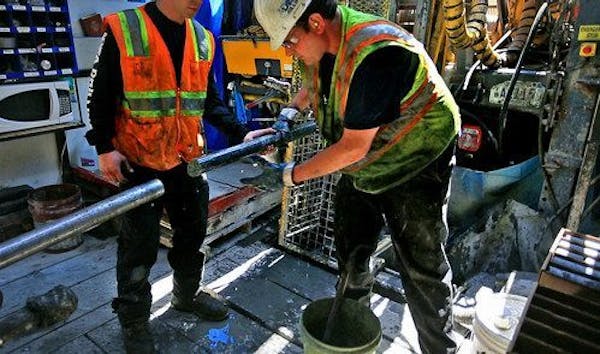With a new mining boom on the horizon for Minnesota's Iron Range, lawyers for a coalition of conservation groups told an appellate panel Thursday that state rules governing metal mining are inadequate to protect the environment.
The case is the first legal test of Minnesota's environmental rules for copper-nickel mining, and comes as international companies plan the state's first hard-rock mines: two large copper mines near the Boundary Waters Canoe Area Wilderness (BWCA) in northeastern Minnesota.
The Minnesota Center for Environmental Advocacy, Friends of the Boundary Waters Wilderness and other advocacy groups filed a petition challenging the Department of Natural Resources (DNR) rules last December, shortly after the agency issued a key and final permit to PolyMet Mining Inc. The permit to mine was the first ever written under the state's untested rules, and the petition is one of seven legal challenges to PolyMet's project.
At issue is Chapter 6132 of DNR agency rules — "Nonferrous Metallic Minerals Mining" — adopted in 1993. The rules for ferrous mining, such as iron ore and taconite, are not being challenged. The groups have petitioned the Minnesota Court of Appeals to declare the entire chapter of rules invalid, but said Thursday they would agree if the justices simply deemed some of the rules too vague and struck them down.
In court Thursday, Ann Cohen, an attorney the Minnesota Center for Environmental Advocacy, told judges that the nonferrous rules are unconstitutionally vague and lack enforceable standards.
"The DNR has a profound misunderstanding of what a rule needs to include," Cohen said. "Vague rules invite the arbitrary exercise of power."
Cohen offered several examples. One is the definition of what it means to "adversely impact natural resources." She read: "It means an unacceptable level of impact on the natural resources as determined by the commissioner based on an evaluation which considers the value of the resource and the degree of impact."
Then she asked the judges: "Can this court enforce that?"
Jonathan Katchen, a private attorney representing the DNR, told the panel that the rules took years to develop and that Minnesota law vested the state agency "with extremely broad authority."
Katchen said there's nothing wrong with general rules lacking numeric standards, as long as there is a regulatory process in place.
"When you're dealing with a complex industry, it's fine to have more general rules," Katchen said. "You don't have a one-size-fits-all mine."
Jay Johnson, a lawyer for PolyMet, which asked to be part of the case, said the term "standards" does not appear in the state's Mineland Reclamation Act, the 1969 law that authorized the DNR to adopt mining rules.
"The DNR is supposed to have flexibility," Johnson said.
The three-judge panel is expected to make a decision in 90 days.
If the state's rules were struck down, it wouldn't flatly stop PolyMet. The environmental groups would likely amend another action, an appeal of the DNR's decision to grant PolyMet a mining permit, to have the permit declared invalid.
That's a move PolyMet would no doubt vehemently oppose.
Katchen works in the Anchorage office of the Denver-based Holland & Hart law firm. The DNR has paid Holland & Hart more than $1 million since the start of 2018 for legal services related to the PolyMet project, state records show. Gov. Tim Walz has asked the Legislature to give the DNR and state Pollution Control Agency $5.6 million for legal support in fiscal 2020-21 to defend the agencies' decisions on various matters, including PolyMet, but the final amount has yet to be determined.
About 30 people attended the arguments, many of them conservationists, including a retired Iron Range miner from Soudan who opposes the mines, and six members of the White Earth, Leech Lake and Fond du Lac tribes.
In an interview after the hearing, Karen Durfee, a Fond du Lac tribal elder, said she and her friends drove the three hours to St. Paul because they worry that the PolyMet mine will pollute their waters. Their land is on the St. Louis River, downstream from the PolyMet project site.
Metal mining has a troubled track record of spills and pollution. According to the U.S. Environmental Protection Agency, metal mining is responsible for half of all industrial chemical releases in the United States.
"What gave them the right — a foreign company — to just come in and cream the wilderness?" Durfee asked. "All the money in the world won't be able to replace that."
The two copper mine proposals have deeply polarized the state, with mining proponents predicting a return to prosperity for the Iron Range and opponents arguing the environmental risks are too great in a part of the state with pristine lakes and forests.
PolyMet is a Toronto-based, publicly held company in which Swiss mining giant Glencore is a major shareholder. The company said in a brief that it has relied on the existing mining rules to recruit employees and contractors for its facility in Hoyt Lakes and to secure the $1 billion it needs to build the open-pit mine.
PolyMet plans to build an open pit copper-nickel mine on the site of an existing taconite mine near Babbitt, and has cleared all state regulatory hurdles. The mine will provide 360 full-time jobs and inject $515 million into the economy of St. Louis County, the company says.
Twin Metals Minnesota, a subsidiary of the Chilean mining company Antofagasta, wants to build an underground copper mine south of Ely, on the edge of the BWCA. On Wednesday, the U.S. Department of the Interior officially renewed the company's minerals leases for that project.
Jennifer Bjorhus • 612-673-4683

Fall or spring, it's Rochester Mayo's year in prep tennis

Minneapolis reaches $150k settlement with eyewitness of George Floyd's murder

Israel-Hamas war creates 'really fraught times' at Minn. colleges

Rare and fatal brain disease in two deer hunters heightens concerns about CWD

